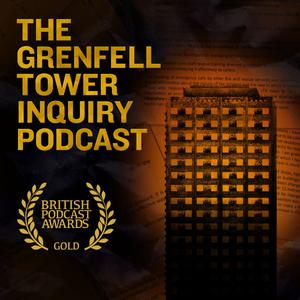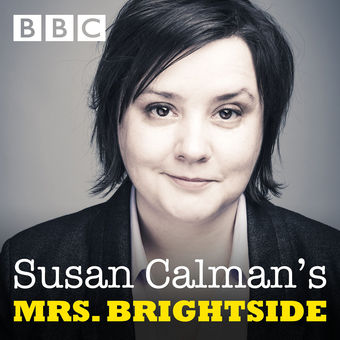
The Grenfell Tower Inquiry Podcast
BBC
Every week the Grenfell Tower Inquiry sits, we analyse and explain the evidence heard.
- 44 minutes 45 seconds204 The Phase 2 Report and the End of the Inquiry
The Inquiry’s Phase 2 report was released this week, distilling 400 days of evidence and more than three hundred thousand documents. The report concluded the fire which killed 72 people was the culmination of “decades of failure” by government and others in the construction industry. It set out a “path to disaster” stretching back to the early 1990s and criticised organisations at every level. It said companies in the industry were “dishonest” and that all deaths in the fire were “avoidable” and that residents were “badly failed” by those responsible for their safety.
Presenter: Kate Lamble
Producer: Sharon Hemans
Researcher: May Cameron
Sound Engineer: Hal Haines
Editor: Penny Murphy
6 September 2024, 5:58 pm - 2 minutes 30 secondsGrenfell: Building a Disaster - Episode 0
In the early hours of the 14th of June 2017, a fire broke out in a tower block in West London. This fire was both a personal tragedy and a national scandal.
It began in Flat 16 of Grenfell Tower. Before long, the flames reached combustible cladding and insulation, which had been installed on the outside of the building. Less than twenty minutes later, the fire had climbed 19 storeys to the top of the tower, ripping through the flammable materials. The tower was engulfed in flames at a staggering speed. Seventy two people lost their lives, hundreds lost their homes.
For the past six years, a public inquiry has been hearing evidence about what lies behind the worst residential fire in UK peacetime in one of the richest areas of the country. Kate Lamble has reported on it since the beginning. And in this series, she tries to understand what created the conditions for a fire which was both foreseeable and preventable.
The answer takes us to the heart of how Britain works, from the government and regulation, to business. This is a story of corporate deceit, government deregulation and a construction industry engaged in a race to the bottom. It’s a story of missed opportunities, unheeded warnings and the failure of a state to protect its citizens.
6 September 2024, 12:44 pm - 15 minutes 46 secondsGrenfell: Building a Disaster - Ep 10: The Final Act
As the sun rises, the local council, the Royal Borough of Kensington and Chelsea are responsible for helping families try and find their loved ones and arranging accommodation for those who have just escaped Grenfell Tower.
But as the situation spirals out of control, lost keys, “dehumanising” processes and slow support for residents lead to frustration and confusion.
Presenter: Kate Lamble Producer: Josephine Casserly Production coordinator: Janet Staples Audio engineers: James Beard and Gareth Jones Story consultant: Simon Maybin Editor: Penny Murphy
4 September 2024, 9:40 am - 14 minutes 11 secondsGrenfell: Building a Disaster - Ep 8: The Smoke
When Ed Daffarn opens his door in the early hours of the morning of the 14th of June 2017, he is confronted by a wall of thick acrid smoke.
As the combustible cladding and insulation burned, smoke gathered rapidly in the hallways and stairwells of Grenfell. It prevented many residents from leaving their flats - and ultimately, it is the smoke which killed those who died in the tower.
The reason this smoke spread so quickly through the building is due to one small detail, which could easily be considered as inconsequential, but on the night of the fire was far from it.
Presenter: Kate Lamble Producer: Josephine Casserly Production coordinator: Janet Staples Audio engineers: James Beard and Gareth Jones Story consultant: Simon Maybin Editor: Penny Murphy
4 September 2024, 9:35 am - 16 minutes 52 secondsGrenfell: Building a Disaster - Ep 9: Stay Put
On the top floor of Grenfell Tower, Marcio Gomes and his family are waiting. Outside, the fire has wrapped itself around 3 sides of the building. But Marcio can’t see any of this. He’s relying on the information given to him by 999 call handlers, and they are telling residents they are safest to remain where they are. Marcio has a decision to make: does he wait for firefighters to reach him, or does he take his pregnant wife and daughters into the black void of suffocating smoke that has gathered in front of his door.
In this episode, Kate tells the story of the final hours of the fire - of Rania Ibrahim and her daughters and Marcio Gomes and his family.
Presenter: Kate Lamble Producer: Josephine Casserly Production coordinator: Janet Staples Audio engineers: James Beard and Gareth Jones Story consultant: Simon Maybin Editor: Penny Murphy
4 September 2024, 9:35 am - 14 minutes 9 secondsGrenfell: Building a Disaster - Ep 7: The Fire
In the early hours of the 14th June 2017, the bell in North Kensington’s fire station begins to ring. Firefighter David Badillo assumes it is a routine house fire. He expects that he and his colleagues will extinguish it quickly and head back to the station.
But when he ventures inside the tower, David Badillo realises that this fire is like nothing he’s seen before.
In this episode, Kate tells the story of the beginning of the night of the fire and asks whether the firefighters who risked their lives were adequately trained and prepared for an event which, for many, was foreseeable.
Presenter: Kate Lamble Producer: Josephine Casserly Production coordinator: Janet Staples Audio engineers: James Beard and Gareth Jones Story consultant: Simon Maybin Editor: Penny Murphy
4 September 2024, 9:30 am - 15 minutes 45 secondsGrenfell: Building a Disaster- Ep 6: Value Engineering
When Grenfell resident Ed Daffarn first heard about the multimillion pound refurbishment of the tower, he welcomed it. The estate had, in his view, become increasingly run down in recent years.
But as the refurbishment progressed, he says residents felt their voices weren’t heard. Meanwhile architects and contractors selected materials which would burn easily in a fire.
Kate looks at how cost-cutting and a race to the bottom in the construction industry had devastating consequences for the refurbishment of Grenfell Tower.
Presenter: Kate Lamble Producer: Josephine Casserly Production coordinator: Janet Staples Audio engineers: James Beard and Gareth Jones Story consultant: Simon Maybin Editor: Penny Murphy
4 September 2024, 9:25 am - 14 minutes 57 secondsGrenfell: Building a Disaster - Ep 5: Single Point of Failure
Why didn't the civil service act on warnings about combustible building materials?
You’ve probably not heard of Brian Martin but he’s central to the story of Grenfell. The civil servant responsible for the fire safety section of the building regulation guidance, he has described himself as the “single point of failure”.
Kate talks to someone who tried to raise the alarm with him, and asks why he didn’t act on warnings about dangerous cladding.
Under the Conservative-Lib Dem coalition government, this was a time of deregulation and cutting red tape. Did these attitudes to health and safety prevent action being taken?
Presenter: Kate Lamble Producer: Josephine Casserly Production coordinator: Janet Staples Audio engineers: James Beard and Gareth Jones Story consultant: Simon Maybin Editor: Penny Murphy
4 September 2024, 9:20 am - 17 minutesGrenfell: Building a Disaster - Ep 4: Who Gives a Damn
A tale of “deliberate and calculated deceit”.
Beneath the cladding, a layer of insulation surrounded Grenfell Tower. This too was combustible and on the night of the fire, contributed to how quickly the flames spread. The companies which produced this insulation have been accused of misleading the construction industry about how combustible their products were.
In this episode, Kate looks through some of the most jaw-dropping evidence from the public inquiry. Internal emails and company documents expose how insulation companies tested, marketed and sold their flammable products.
Presenter: Kate Lamble Producer: Josephine Casserly Production coordinator: Janet Staples Audio engineers: James Beard and Gareth Jones Story consultant: Simon Maybin Editor: Penny Murphy
4 September 2024, 9:15 am - 16 minutesGrenfell: Building a Disaster - Ep 3: Bad Behaviour
How manufacturers sold combustible cladding
When Marcio Gomes found out that Grenfell Tower, where he lived, was going to be covered in cladding, he assumed it must be safe. Today we know this material was the main cause of the spread of the fire at Grenfell Tower.
The cladding installed on the tower was made by French company, Arconic - it was highly combustible. Prior to the fire at Grenfell, Arconic staff were warned that covering a tower block in this material could add the fuel power of an oil tanker to the outside walls. Why did they sell it anyway? And how was that allowed?
Presenter: Kate Lamble Producer: Josephine Casserly Production coordinator: Janet Staples Audio engineers: James Beard and Gareth Jones Story consultant: Simon Maybin Editor: Penny Murphy
4 September 2024, 9:10 am - 14 minutes 51 secondsGrenfell: Building a Disaster - Ep 2: Building Blocks
How a fire in Scotland in 1999 foretold the fire at Grenfell Tower.
In 1999, a dropped cigarette started a tower block fire in a small town on the west coast of Scotland. The building, which had been recently clad in flammable materials, is said to have caught fire like matchwood. This was one of the first signs that combustible materials were being permitted in the building sector in the UK. These risks were even raised with the New Labour government – so why didn’t they act?
How did the UK’s regulations allow for such materials to be used on high rise buildings? And how did government deregulation in the 1980s shape attitudes to health and safety?
Presenter: Kate Lamble Producer: Josephine Casserly Production coordinator: Janet Staples Audio engineers: James Beard and Gareth Jones Story consultant: Simon Maybin Editor: Penny Murphy
4 September 2024, 9:05 am - More Episodes? Get the App
Your feedback is valuable to us. Should you encounter any bugs, glitches, lack of functionality or other problems, please email us on [email protected] or join Moon.FM Telegram Group where you can talk directly to the dev team who are happy to answer any queries.
 Podcasting House
Podcasting House
 Podcast Radio Hour
Podcast Radio Hour
 Brexit: A Love Story?
Brexit: A Love Story?
 Susan Calman's Mrs Brightside
Susan Calman's Mrs Brightside